Pesticide usage in Scotland: arable crops and potato stores 2016
This publication presents information from a survey of pesticide use on arable crops and potato stores in Scotland during 2016.
This document is part of a collection
Appendix 4 – Survey methodology
Sampling and data collection
Using the June 2016 Agricultural Census (13), a sample was drawn representing arable cultivation in Scotland. The country was divided into 11 land-use regions ( Figure 56). Each sample was stratified by these land-use regions and according to holding size. The sampling fractions used within both regions and size groups were based on the areas of relevant crops grown rather than number of holdings, so that smaller holdings would not dominate the sample.
The survey covered pesticide applications to arable crops where all or the majority of the growing season was in 2016. As well as recording treatments applied directly to the crop, data was also collected on land preparation treatments prior to sowing or planting the crop.
Following an introductory letter and phone call, data were collected by either personal interview during a visit to the holding or during a phone interview or by email. Where necessary, information was also collected from agronomists and contractors. In total, information was collected from 288 holdings growing arable crops (Table 44). These holdings collectively represent seven per cent of the total Scottish arable crop area grown.
Raising factors
National pesticide use was estimated by ratio raising. This is a standard statistical technique for producing estimates from a sample. It is the same methodology used by the other UK survey teams and has been used for all historical datasets produced by the Pesticide Survey Unit, allowing comparability over time. The sample data were multiplied by raising factors (Table 47). These factors were calculated by comparing the sampled area to the areas recorded in the Agricultural Census within each region and size group. An adjustment (Table 48) was made for each crop within each region by applying the raising factors to the sample area of each crop grown and comparing this with the census area. This adjustment modifies the estimate to take into account differences in composition of crops encountered in the sample and those present in the population. A second adjustment was necessary for some crops which were present in the population, but were not encountered in the sample in some strata.
Figure 56 Land use regions of Scotland (15)

Changes from previous years
Winter rye is included in the 2016 report for the first time. The area grown in Scotland has significantly increased to 3,725 hectares in 2016. It was previously recorded in the 'Other crop' category of the June Agricultural Census but will be recorded in a separate census category from 2017.
The 2016 report contains a number of new details to help improve data quality for users. Data relating to the average number of applications for each crop and type of pesticide have been included in Table 1 and Figures 13 and 14. Details relating to pesticide application timings for each crop have been included in the pesticide usage section. Fungicides, herbicides and insecticides have been classified into groups according to their mode of action and chemical group in Tables 34-36. Data on Integrated Pest Management activities (i.e. non-chemical methods to control pests, weeds and diseases) has been collected from farmers and is reported in Appendix 6.
The total number of refusals to participate in this voluntary survey (36 per cent) has increased from 23 per cent in 2014 and 12 per cent in 2012. This has resulted in a 2016 sample size 18 per cent lower than the target. It is possible that this decrease in sample size may influence the estimates made in this report, although the very similar relative standard errors reported between the last two surveys provides some reassurance that the statistical robustness of the data has not been compromised.
Data quality assurance
The dataset undergoes several validation processes as follows; (i) checking for any obvious errors upon data receipt (ii) checking and identifying inconsistencies with use and pesticide approval conditions once entered into the database (iii) 100 per cent checking of data held in the database against the raw data. Where inconsistencies are found these are checked against the records and with the grower if necessary. Additional quality assurance is provided by sending reports for review to members of the Working Party on Pesticide Usage Surveys and other agricultural experts. In addition, the Scottish pesticide survey unit is accredited to ISO 9001:2015. All survey related processes are documented in Standard Operating Procedures ( SOPs) and our output is audited against these SOPs by internal auditors annually and by external auditors every three years.
Main sources of bias
The use of a random stratified sample is an appropriate survey methodology. A stratified random sample, grouped by farm size and region, is used to select holdings used in this survey. Sampling within size groups is based on area rather than numbers of holdings, so that smaller size groups are not over-represented in the sample. The pesticide survey may be subject to measurement biasas it is reliant on farmers/growers recording data accurately. As this survey is not compulsory it may also subject to non-response bias, as growers on certain farm/holding types may be more likely to respond to the survey than others. Reserve lists of holdings are held for each stratum to allow non-responding holdings to be replaced with similar holdings.
Experience indicates that stratified random sampling, including reserves, coupled with personal interview technique, delivers the highest quality data and minimises non-response bias.
Contact
There is a problem
Thanks for your feedback